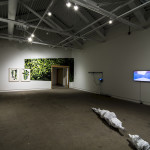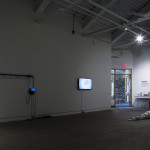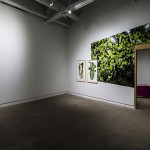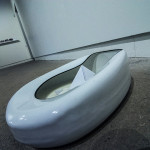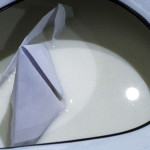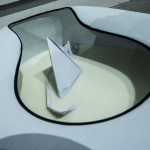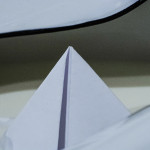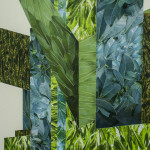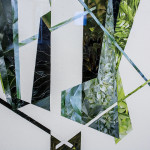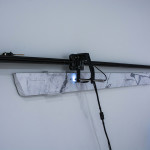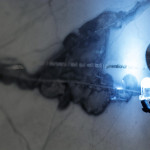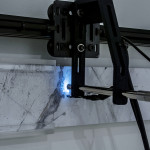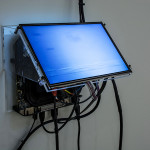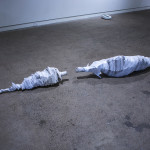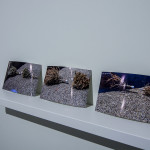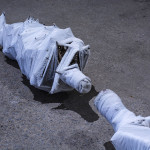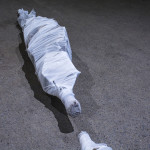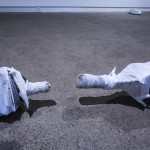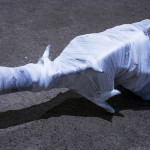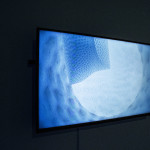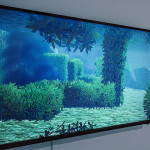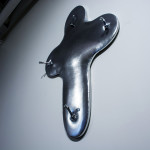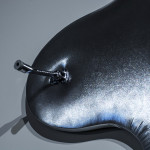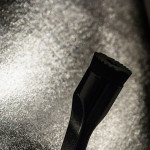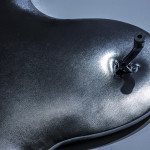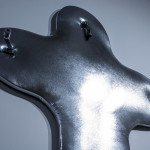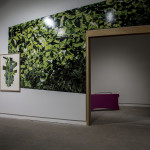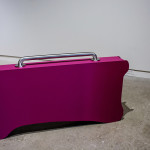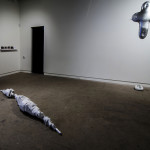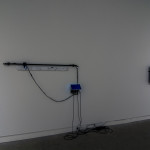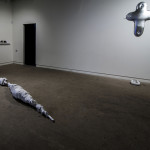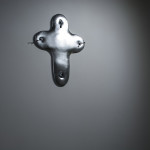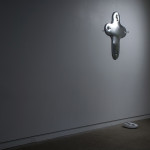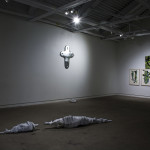Ritualia
Modernfuel Artcentre, Kingston / January 14 – February 24, 2018 / curated by Matthew Kyba
According to theorist Jane Bennett, our culture is widely understood to be devoid of a sense of enchantment, which is the experience of being “struck and shaken by the extraordinary that lives amid the familiar and the everyday.” Using different strategies to symbolize modern-day rituals, artists Lumir Hladik, Dagmara Genda, Anna J. Eyler, and Nicolas Lapointe aim to uncover these extraordinary instances in daily life, through objects that disrupt and question common human routines and habits. A ritual is a rigid, sequenced behaviour, a habitual “pattern”, as human brains cherish and seeks repetition. It is a method of surviving information overload. Rituals range from solemn sacred ceremonies to trivial tasks. They all have one common trait: irrationality, for they are performed, in most cases, with little connection to their original meaning.
Everyday rituals combine into amalgamated meshes of time nondescript, blended into a puree of unconscious action. How do we experience the passing of time, when so much leaks unnoticed? Instead of pointing out the comatose-esque monotony that so many of our daily tasks are carried out, each artist instead asks us to consider what our rituals mean, why they are the bedrock for our daily lives, and finally through what means are they performed? Especially in prescribed art institutional settings, the rituals of an “opening”, “artist talk”, and even “networking” takes on realized and practiced actions – pre-determined modes of interaction separate from critical thinking in order to better facilitate an ease of completion.
Many artists blur the line between the everyday ritual and art. Moving focuses away from the object, artists such as Tino Segal have used ritual experiences as the medium for disruption. “Time” is an integral part to practices as such as they are performed as “happenings” over a very specific duration. We can roll in “relational aesthetics,” a movement that questions the very definition of what art can be, and how art performance can include common rituals such as serving soup within a gallery. What separates Ritualia from these aforementioned artistic groups has to do with using the art object as a vehicle for a richer understanding and questioning of daily comings and goings. Instead of depending on the action, the instance, or the performance of said ritual, each artist works alongside the knowledge of repeated tasks to both inform and critique various human functions and assumptions.
Anna Eyler’s practice involves digital realms that tease larger issues within contemporary society. Focusing on technology’s larger relationship to reality, Eyler uses the engine for Second Life – a popular online game where world creation takes centre stage in order to delve into the vast creativity of online reality. The work, How to Live Forever (Trimming the Myrtle-bush) (2016), is of slowly repeated actions by virtual shapes in captivity. Twisting, gyrating, pacing, and other monotonous actions are performed onscreen by these digital geometric bodies, as if going through routine while we meditate as to the reason for these repeated movements. From Eyler’s statement:
In “This Is Not a Game: Violent Video Games, Sacred Space, and Ritual,” religious studies scholar Rachel Wagner notes the strong similarities between sacred and secular play, as each function within a temporarily “real” world according to established rules. The “trimming of the myrtle-bush” refers to Robert Browning’s poem “Soliloquy of the Spanish Cloister,” which exposes the tensions of cloistered life by focusing on a Dominican monk’s desire for the flesh over the spirit.
What do these figures desire? Making connections to animal captivity, as the shapes are clad in natural environment flora and imagery, what does it mean to held captive within human-constructed settings? These rituals of the controlling of animals, environment, and our natural surroundings often conflict many other society’s hierarchy of importance; Western civilization likes to put the human being over top of everything else. Eyler looks at the harm this pre-determined and socialized behavior indicates, as well as the submission of different species to humankind. What we take for granted and the consequences of such rituals will surely return, and be reciprocated, in the future.
Dagmara Genda’s installation also involves the digitalization of nature and how these two realms co-exist and clash. Beating the Bush is a series of digital collages and installation made by reorganizing photographs of leaves photographed over varied light conditions. Our impulse to organize nature according to human ideals of rationality. Nature is rendered clean and decorative (wallpaper, framed pictures) and simultaneously serves to make our systems seem natural or inevitable (from gardens and agriculture to patriarchy). Just like many ritualistic tendencies, we have an “archival impulse” (from Derrida) that we continuously pattern nature in order to make sense of it. Parallel to this rationalizing endeavor is Genda’s process—an irrational need to organize something that can’t be organized—i.e. light. By photographing a bush in different conditions and reorganizing those leaves, she’s attempting to reify something fleeting. The sheer immensity of labour and repetition comes to stand in for the order that the project lacks. The tedious and laborious process Genda undertakes to create these artificial settings cannot be undersold. How do we situate, dominate, control, and subjugate nature through our daily and monotonous actions in order to appear superior?
Interestingly enough, Genda and Eyler showcase the almost “unnatural” quality of geometric shaping on artificial plant-life. Both artists identify the resulting collapse of the digital and organic realms, highlighting the fraught spatial relationships natural, manufactured, and digital entities have to time—a relationship predicated on common human patterns that increasingly conflates those three realms.
Appropriating both natural and non-natural elements, Lumir Hladik’s work in Ritualia incorporates ready-mades, intervention, installation, and real-life environmental components. Concerned with Humanity’s lack of respect for death, and all the grandstanding of humankind’s “authority” over everything else, Hladik’s practice attempts to re-introduce conversations about our position within a universal expanse. Outside on the gallery’s parking lot fence, Hladik’s action/installation involves gauzed tubes that penetrate through the chain link fence, a rope connects them as an ouroboros circuit. Speaking to the farcicality of man-made borders, Hladik disrupts notions of divide. Standing alone in the centre of the gallery is a remnant from rituals past – gauze-clad and fully naked, needleless, and lifeless pine Xmas trees. The ironic classification of the evergreen laying curled up, browned from time passing, is not lost on Hladik. His works often act as interventions into daily happenings, such as how we view and understand time. The idea of “eternity/mortality”, a noble concept created to relay a sense of permanence, relates back to how time is measured and understood but never fully grasped. The murder of trees for three days of pleasure, a permanent snuffing out of life, an irreversible forever, is the arrogance of the anthropomorphic view that our universe is at humankind’s disposal. Looming over the deceased trees is a softly rounded cross, wrapped in gleaming silver spandex with door holders attached to the limbs. With using nearly identical aesthetics to gym equipment, he makes a connection to the masochistic tendency of both religion and exercise. Interested in our fascination with daily rituals such as these, Hladik’s neo-modern interpretation of the cross examines the efficaciousness of faith and the ritual of worship to everyday tasks.
Nicolas Lapointe’s work adorns the far wall, slowly scrolling back and forth monotonously. His work concerns the relationship between digital technology and the mystical-occult, two somewhat disparate concepts married through Lapointe’s careful and deliberate fusing of old and new technologies. Lapointe notes
“…mechanical structures recall the polish and precision of industrial production, simulating scientific methods and techniques. Through video, certain works reference the low-quality documentation of supernatural phenomena, while others map virtual non-space using computer-generated imagery. In either case, the works undermine their own apparent logic through the inclusion of unexpected material rooted in popular understandings of the occult.”
The clash of technologies and concepts manifests into the seen work, as the camera feed crawls across the inscribed rock slab, not allowing for any easy consumption of text and instead forcing viewer’s patience for the process. This resistance is the antithesis of current digital practices; the newest technological apparatus needs to be, first and foremost, the fastest at delivering information. Reifying into cyberspaces like Twitter and instant updates on Facebook, we have (in a very short time) been conditioned to crave instant gratification. Troubling the the immediacy and efficiency that is associated with and expected of technology, Lapointe instead focuses on the realm of digital mysticism. Alternatively to Hladik who examines religion, faith, and theism, Lapointe points to the cyber-mystic that disrupts has crept into popular culture as of late. In the post-digital age we live, is there something larger, a metanarrative or zeitgeist that incorporates the virtual realm? This is a question of curiosity and faith – two concepts challenged by Lapointe in order to look critically at our positionality within the 21st century. How do we exist vis-à-vis religion, the occult, and technology?
Matthew Kyba, Toronto January 2018


